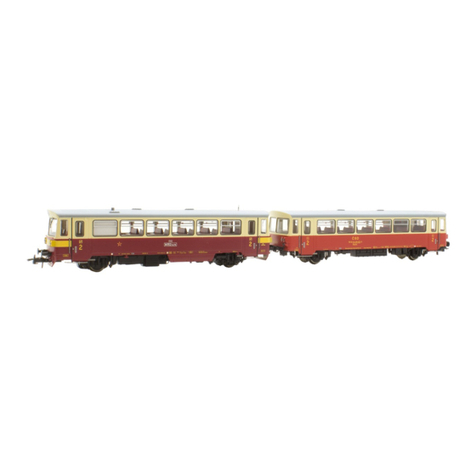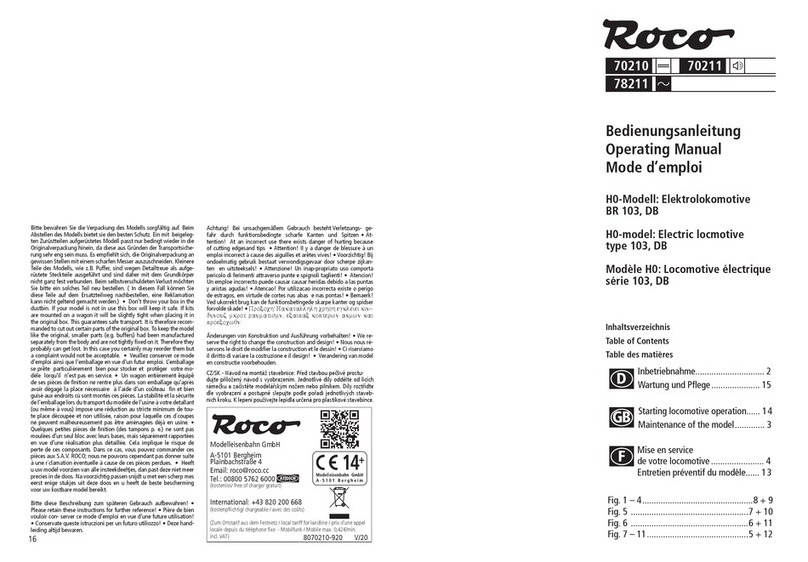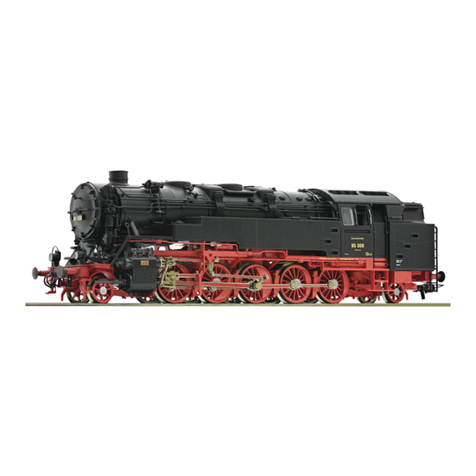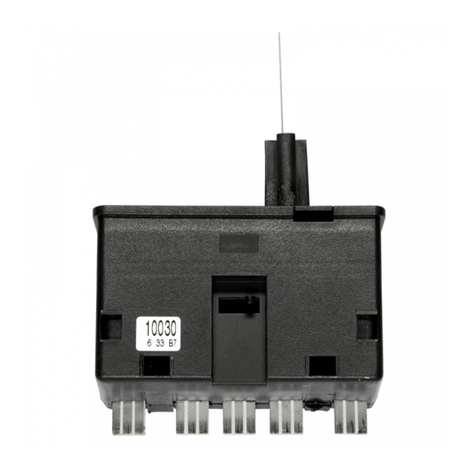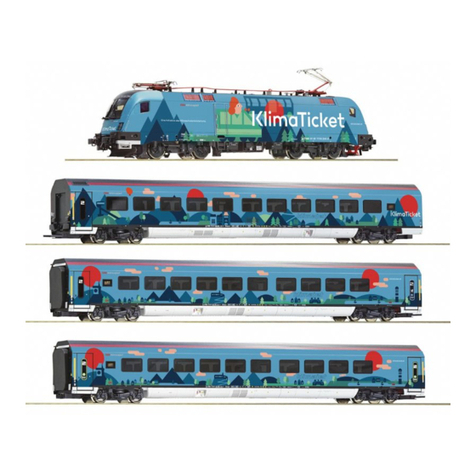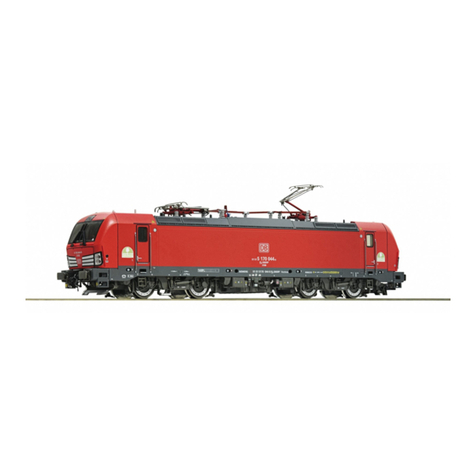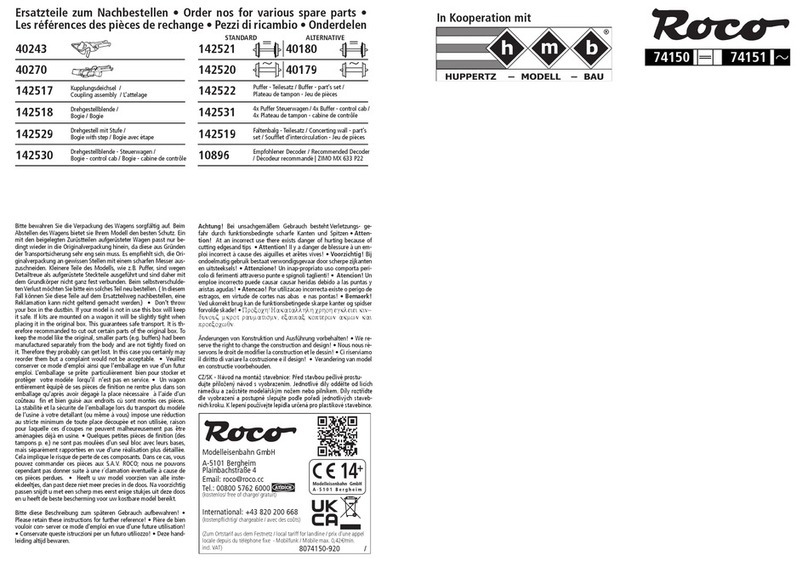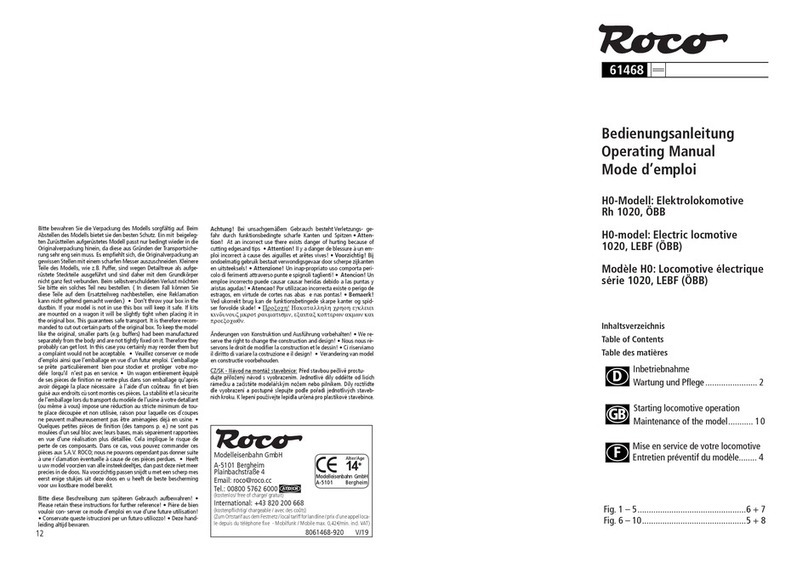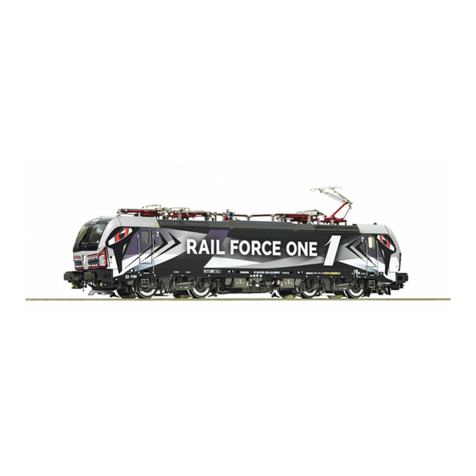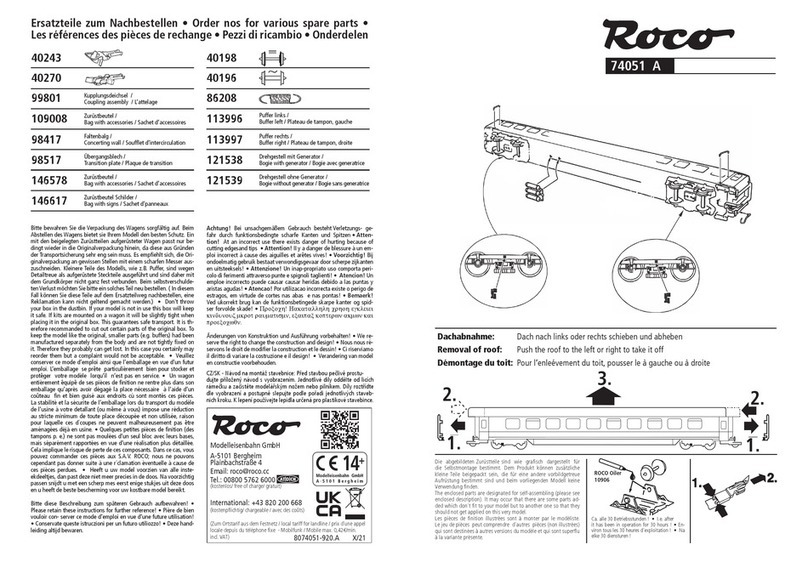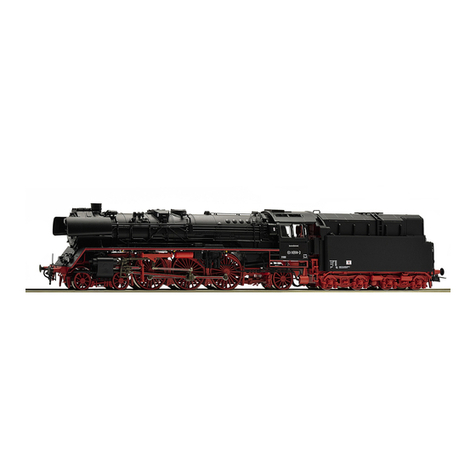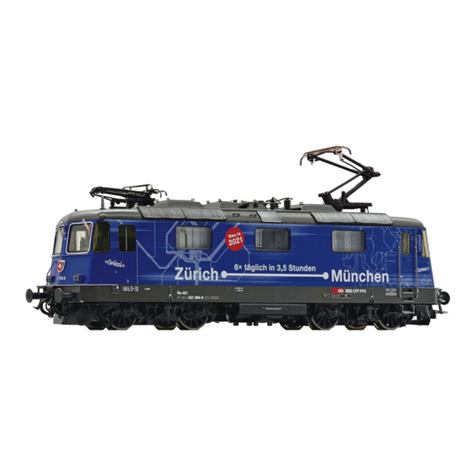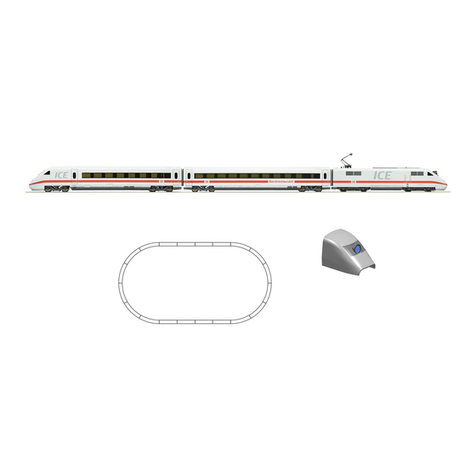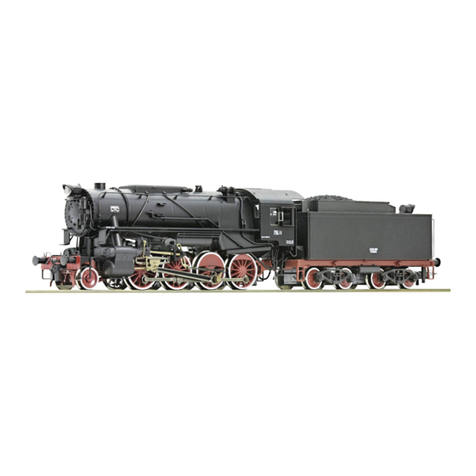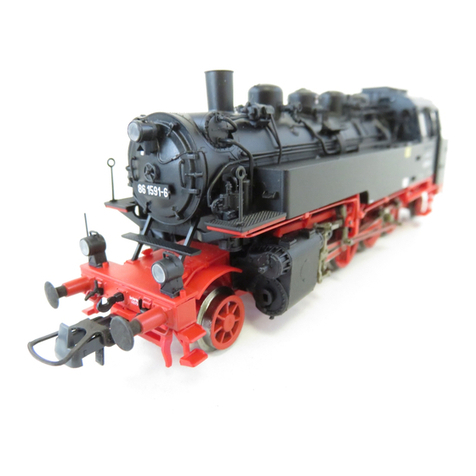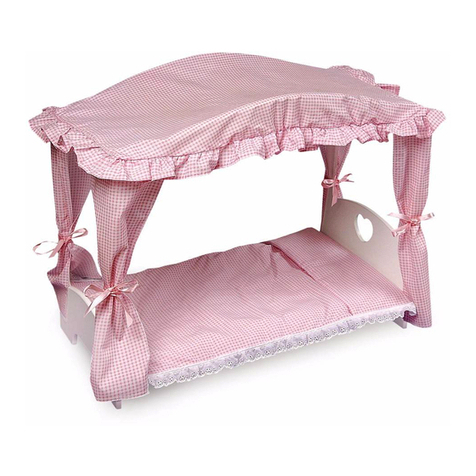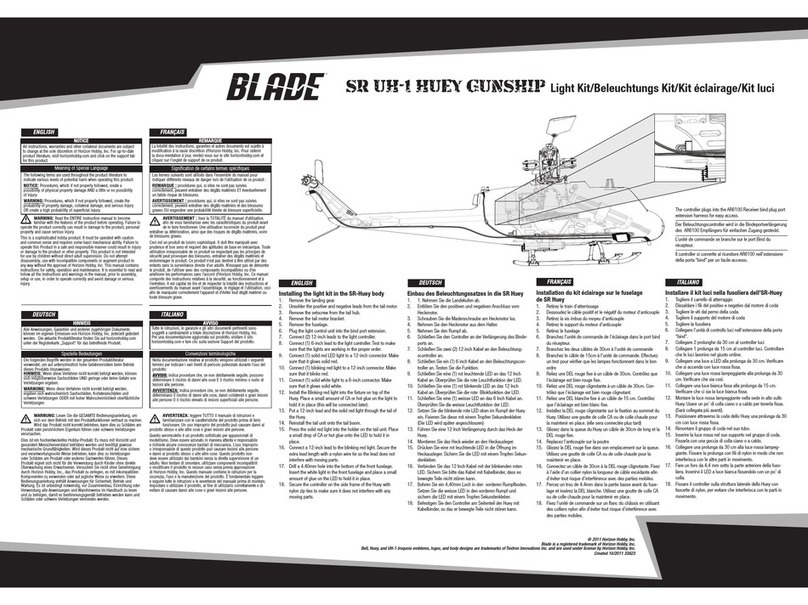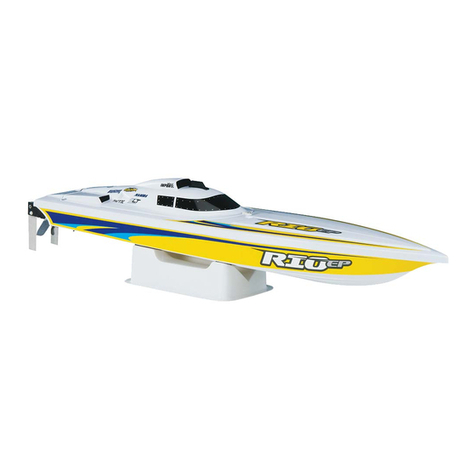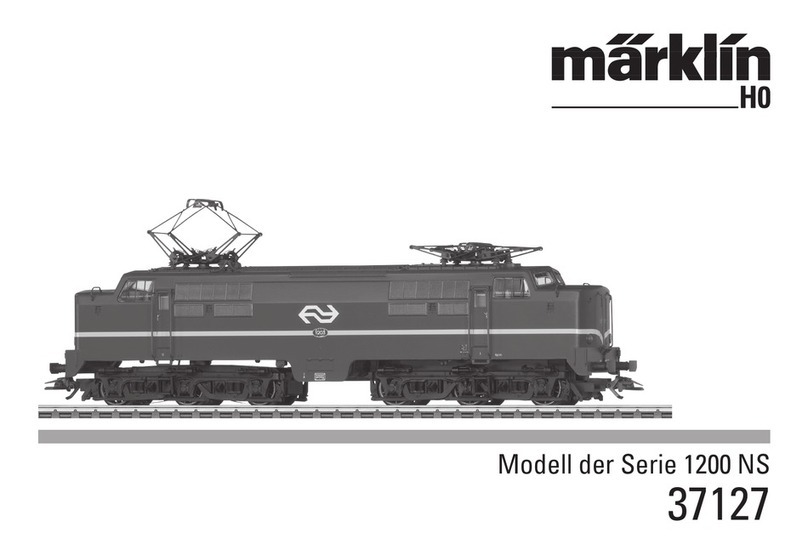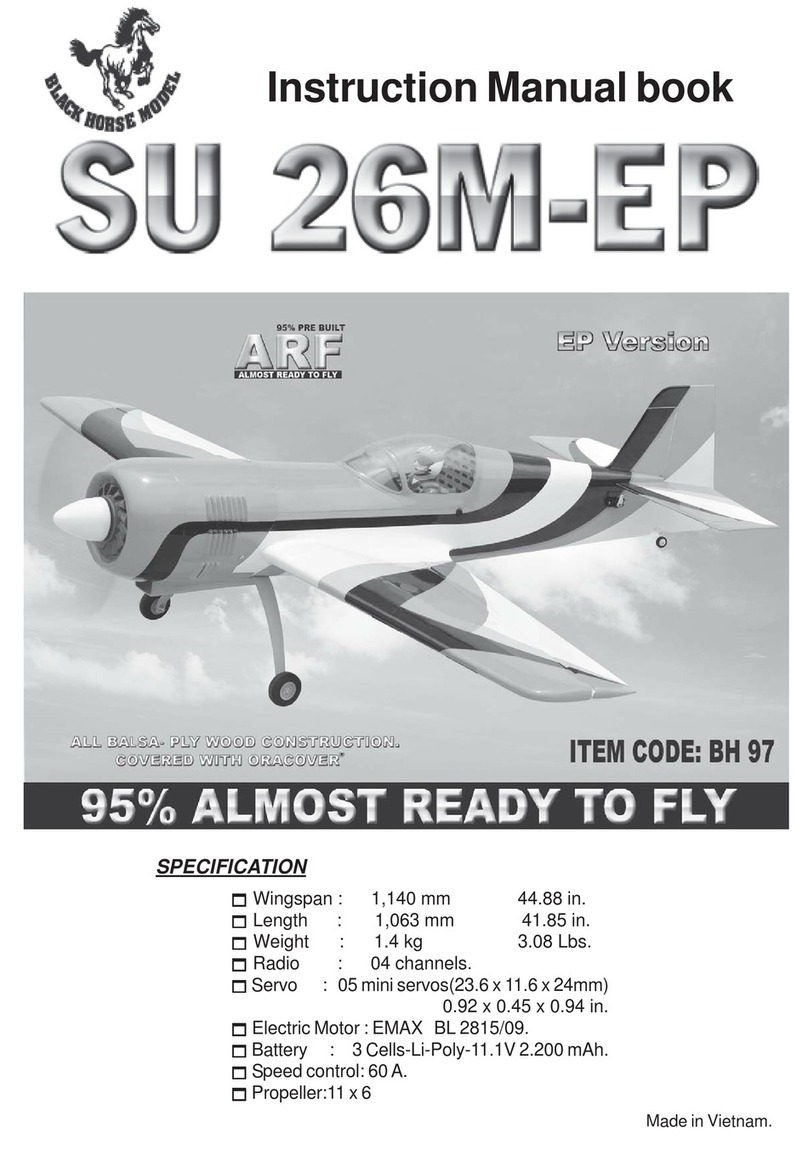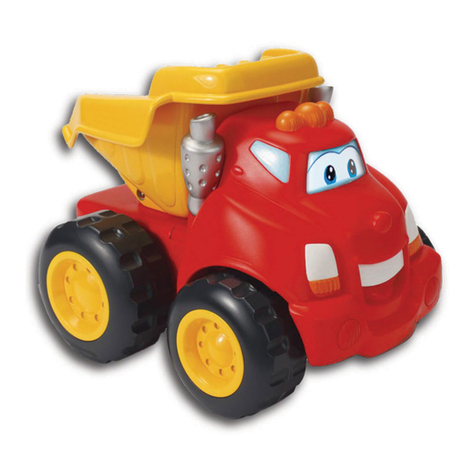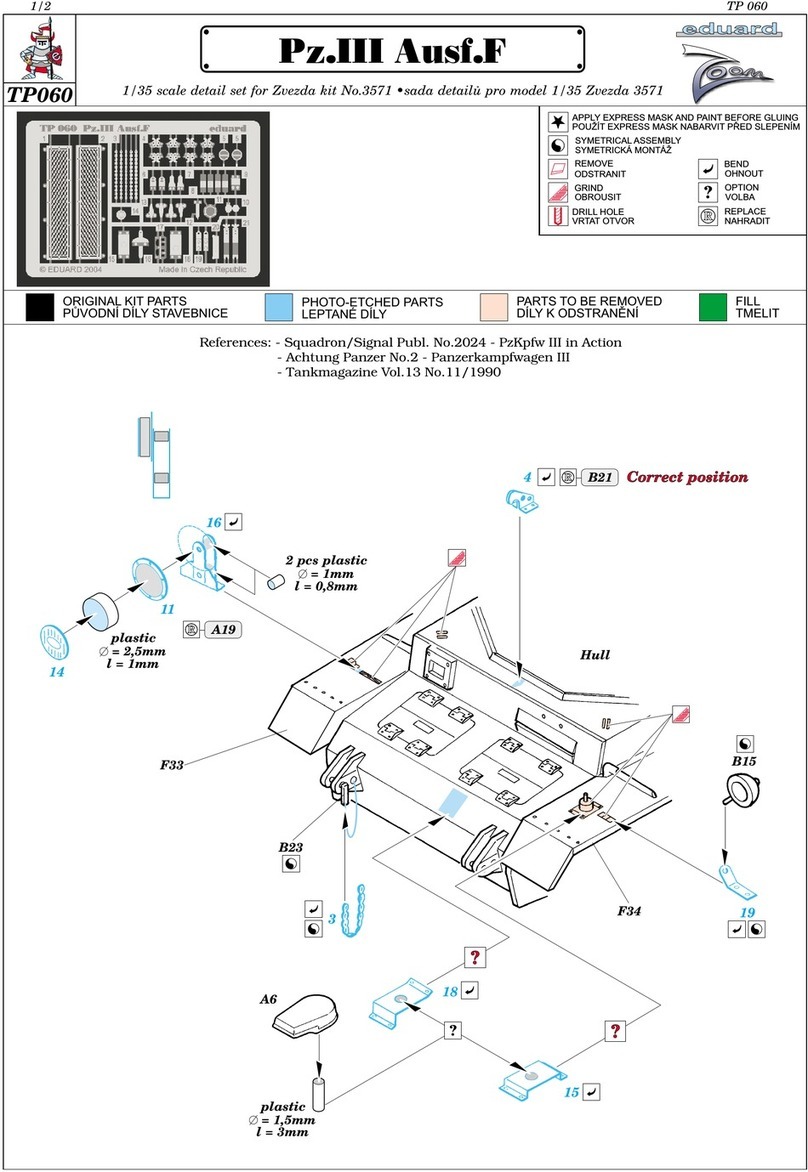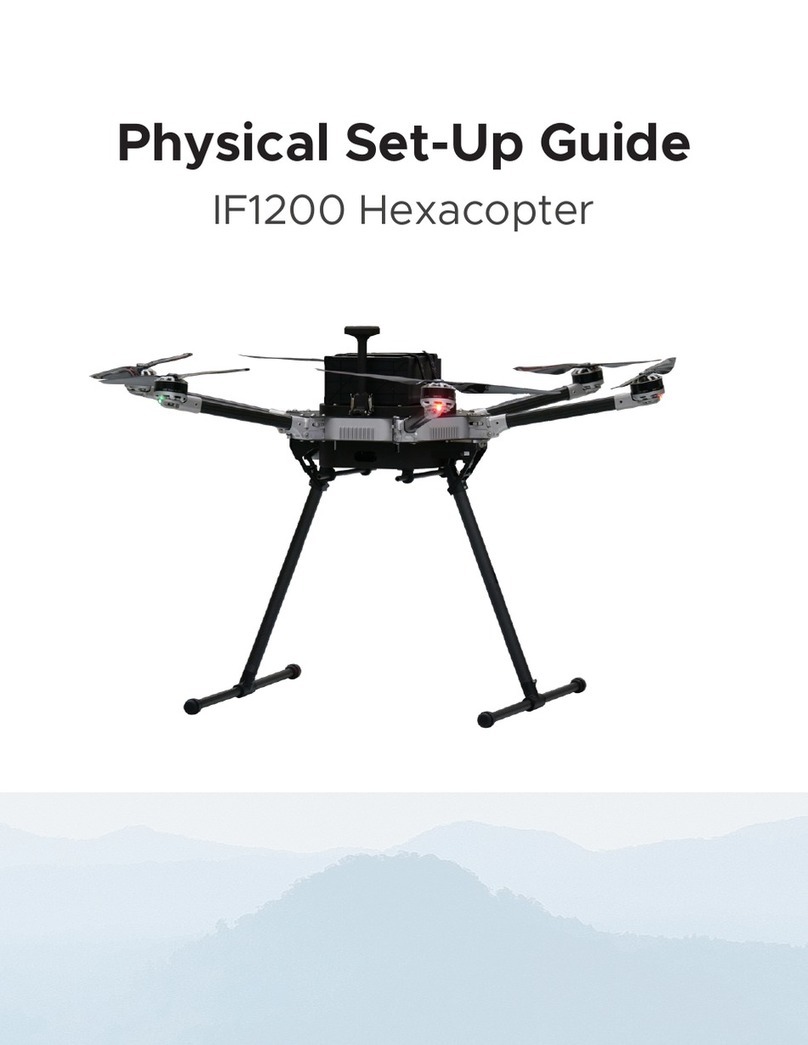roco 71918 User manual

Bedienungsanleitung
Operating Manual
Instrukcja obsługi
Inhaltsverzeichnis
Table of Contents
Spis treści
D
Bitte bewahren Sie die Verpackung des Modells sorgfältig auf. Beim
Abstellen des Modells bietet sie den besten Schutz. Ein mit beigeleg-
ten Zurüstteilen aufgerüstetes Modell passt nur bedingt wieder in die
Originalverpackung hinein, da diese aus Gründen der Transportsiche-
rung sehr eng sein muss. Es empehlt sich, die Originalverpackung an
gewissen Stellen mit einem scharfen Messer auszuschneiden. Kleinere
Teile des Modells, wie z.B. Puffer, sind wegen Detailtreue als aufge-
rüstete Steckteile ausgeführt und sind daher mit dem Grundkörper
nicht ganz fest verbunden. Beim selbstverschuldeten Verlust möchten
Sie bitte ein solches Teil neu bestellen. ( In diesem Fall können Sie
diese Teile auf dem Ersatzteilweg nachbestellen, eine Reklamation
kann nicht geltend gemacht werden.) • Don‘t throw your box in the
dustbin. If your model is not in use this box will keep it safe. If kits
are mounted on a wagon it will be slightly tight when placing it in
the original box. This guarantees safe transport. It is therefore recom-
manded to cut out certain parts of the original box. To keep the model
like the original, smaller parts (e.g. buffers) had been manufactured
separately from the body and are not tightly xed on it. Therefore they
probably can get lost. In this case you certainly may reorder them but
a complaint would not be acceptable. • Veuillez conserver ce mode
d’emploi ainsi que l’emballage en vue d’un futur emploi. L’emballage
se prête particulièrement bien pour stocker et protêger votre mo-
dèle lorqu’il n’est pas en service. • Un wagon entièrement êquipê
de ses pièces de nition ne rentre plus dans son emballage qu’après
avoir dégagé la place nécessaire à l’aide d’un coûteau n et bien
guisé aux endroits cù sont montés ces piéces. La stabilité et la sécurite
de l’emballage lors du transport du modèle de l’usine à votre detallant
(ou même à vous) impose une réduction au stricte minimum de tou-
te place découpée et non utilisée, raison pour laquelle ces d´coupes
ne peuvent malheureusement pas être aménagées déjà en usine. •
Quelques petites pièces de nition (des tampons p. e.) ne sont pas
moulées d’un seul bloc avec leurs bases, mais séparément rapportées
en vue d’une réalisation plus détaillée. Cela implique le risque de
perte de ces composants. Dans ce cas, vous pouvez commander ces
pièces aux S.A.V. ROCO; nous ne pouvons cependant pas donner suite
à une r´clamation èventuelle à cause de ces pièces perdues. • Heeft
u uw model voorzien van alle insteekdeeltjes, dan past deze niet meer
precies in de doos. Na voorzichtig passen snijdt u met een scherp mes
eerst enige stukjes uit deze doos en u heeft de beste bescherming
voor uw kostbare model bereikt.
Bitte diese Beschreibung zum späteren Gebrauch aufbewahren! •
Please retain these instructions for further reference! • Pière de bien
vouloir con- server ce mode d’emploi en vue d’une future utilisation!
• Conservate queste istruczioni per un futuro utiliozzo! • Deze hand-
leiding altijd bewaren.
Achtung! Bei unsachgemäßem Gebrauch besteht Verletzungs- ge-
fahr durch funktionsbedingte scharfe Kanten und Spitzen • At-
tention! At an incorrect use there exists danger of hurting because
of cutting edgesand tips • Attention! II y a danger de blessure à un
emploi incorrect à cause des aiguilles et arêtes vives! • Voorzichtig! Bij
ondoelmatig gebruik bestaat verwondigsgevaar door scherpe zijkan-
ten en uitsteeksels! • Attenzione! Un inap-propriato uso comporta
pericolo di ferimenti attraverso punte e spignoli taglienti! • Atencion!
Un emploe incorrecto puede causar causar heridas debido a las puntas
y aristas agudas! • Atencao! Por utilizacao incorrecta existe o perigo
de estragos, em virtude de cortes nas abas e nas pontas! • Bemaerk!
Ved ukorrekt brug kan de funktionsbetingede skarpe kanter og spidser
forvolde skade! • Proxoch! Hakatallhlh crhoh egkleiei kin
dunouz mkrot raumatismn, exaipax kopterwn akmwn kai
proexocwqn.
Änderungen von Konstruktion und Ausführung vorbehalten! • We re-
serve the right to change the construction and design! • Nous nous ré-
servons le droit de modier la construction et le dessin! • Ci riserviamo
il diritto di variare la costruzione e il design! • Verandering van model
en constructie voorbehouden.
CZ/SK - Návod na montáž stavebnice: Před stavbou pečlivě prostu-
dujte příložený návod s vyobrazením. Jednotlivé dily odděIte od licích
rámečku a začistěte modelářským nožem nebo pilníkem. Díly roztřídte
dle vyobrazení a postupně slepujte podle pořadi jednotlivých staveb-
nich kroku. K lepení používejte lepidla určená pro plastikové stavebince.
GB
Modelleisenbahn GmbH
A-5101 Bergheim
Plainbachstraße 4
Email: roco@roco.cc
Tel.: 00800 5762 6000
(kostenlos/ free of charge/ gratuit)
International: +43 820 200 668
(kostenpichtig/ chargeable / avec des coûts)
(Zum Ortstarif aus dem Festnetz / local tariff for landline / prix d‘une appel
locale depuis du téléphone xe - Mobilfunk / Mobile max. 0,42€/min.
incl. VAT)
AT|D|CH
PL
16
D
8071918-920 V/20
71918 71919
Fig. 1 – 3................................................8 + 9
Fig. 4 – 7..............................................7 + 10
Fig. 8 ...................................................6 + 11
Fig. 9 – 11............................................5 + 12
H0-Modell: Elektrolokomotive
BR 170, DB-AG
H0-model: Electric locomotive
BR 170, DB-AG
Modèle H0: Elektryczny lokomotywa
BR 170, DB-AG
Inbetriebnahme.............................. 2
Wartung und Pege ..................... 15
Starting locomotive operation...... 14
Maintenance of the model............. 3
Uruchomienie lokomotywy ............ 4
Konserwacja i pielęgnacja modelu.. 13

D D
152
Wartung und Pege des ModellsInbetriebnahme Ihrer Lokomotive
Auspacken des Modells: Das Modell vorsichtig
mit der Folie aus der Packung herausziehen (Fig. 1).
Betriebsbedingungen: Es empehlt sich, das
Modell 30 Minuten vorwärts und 30 Minuten
rückwärts ohne Belastung einlaufen zu lassen,
damit Ihr Modell einen optimalen Rundlauf
und beste Zugkraft bekommt. Der kleinste be-
fahrbare Radius für dieses Modell ist R2 des RO-
CO-Gleissystems (R2 = 358 mm).
Der einwandfreie Lauf Ihrer Lokomotive ist nur auf
sauberen Schienen gewährleistet. Hierzu empfeh-
len wir den ROCO-Schienenreinigungswagen
Art.-Nr. 46400 und bei etwas stärkerer Verschmut-
zung den ROCO-Schienenreinigungs-Gummi
Art.-Nr. 10002.
Aufrüstung: Sie können für Ihren Fahrbetrieb un-
ter verschiedenen Kupplungen wählen (Fig. 2). Wir
empfehlen den Einsatz der ROCO-Kurzkupplung.
Im beigelegten Zurüstbeutel nden Sie auch klei-
ne vorbildgetreue Steckteile für eine erweiterte
Aufrüstung Ihres Modells (Fig. 2+3), die Sie bitte
vorsichtig montieren. Achtung! Kleben nur
mit ausdrücklichem Hinweis.
Mehrzugbetrieb:
Den Brückenstecker aus der Schnittstelle entfer-
nen (diesen sorgsam aufbewahren).
Danach den Stecker des Steuerbausteins lagerich-
tig einsetzen (siehe Fig. 8).
Achtung! Bei Modellen mit Zugzielanzeige ist
deren Beleuchtung sowie die Fernlicht-Funktion
im Analogbetrieb nicht schaltbar!
Ausführung für Wechselstrom:
siehe Fig. 11
Damit Ihnen Ihr Modell lange Freude bereitet, sind
regelmäßig (ca. alle 30 Betriebsstunden) gewisse
Servicearbeiten notwendig:
1. Reinigung der Radstromkontakte: Rad-
stromkontakte können auf unsauberen Schienen
leicht verschmutzen. Entfernen Sie vorsichtig
mit einem kleinen Pinsel den Schmutz an den in
Fig. 6 gekennzeichneten Stellen. Dazu zuerst den
Getriebedeckel abnehmen (Fig. 5).
2. Schmierung: Versehen Sie die im Schmier-
plan in Fig. 9 gekennzeichneten Stellen mit nur
kleinen Öltropfen. Dazu zuerst das Lokgehäu-
se abnehmen (Fig. 4). Wir empfehlen den ROCO
Öler Art.-Nr. 10906. Fürs Schmieren der Getrie-
beteile (Zahnräder, Schnecke) empfehlen wir das
ROCO-Spezialfett Art.-Nr. 10905. Im Falle der
Schmierung diese Teile nicht ölen.
3. Haftreifenwechsel: Zuerst den Getriebede-
ckel abnehmen (Fig. 5). Danach den Radsatz he-
rausnehmen und die Haftreifen mit einer Nadel
od. mit einem feinen Schraubendreher abziehen
(Fig. 7). Beim Aufziehen der neuen Haftreifen dar-
auf achten, dass diese sich nicht verdrehen.
4. Kohlebürstenwechsel: Lokgehäuse abneh-
men (Fig. 4). Danach wird der Motor ausgebaut
und die Kohlebürsten ausgewechselt (Fig. 10).
Zusammenbau: Bitte achten Sie beim Zusam-
menbau auf die richtige Lage der Kontakte.
Position "ON"
Werkseinstellung: Stirnlicht fahrtrichtungsabhängig im Analog- und Digitalbetrieb.
Position „OFF“
Im Analogbetrieb ist das Stirnlicht deaktiviert.
ON
1 2
Führerstand 2 ON Führerstand 1 ON
ON
1 2
Führerstand 2 OFF Führerstand 1 OFF

Position "ON"
Works setting: The headlight is illuminated in the analogue and digital operations, depending on the
direction of travel.
Position „OFF“
In the analogue operation, the headlight is deactivated.
ON
1 2
Drivers Cab 2 ON Drivers Cab 1 ON
ON
1 2
Drivers Cab 2 OFF Drivers Cab 1 OFF
GB GB
14 3
Maintenance of the modelStarting locomotive operation
Unwrap model: Take out the model cautiously
with foil (g. 1).
Operating instructions: Before use is advisab-
le to let the loco go around about 30 minutes for-
wards an 30 minutes backwards without load, to
obtain an optomal circuit and best tractive power.
The smallest radius this model should run is R2 of
the ROCO track system (R2 = 358 mm).
Your locomotive will run smoothly on clean tracks
only. For this purpose we recommend using item
no. 46400, Roco track cleaning van, or item
no. 10002, Roco track cleaning rubber, for
removing heavy dirt.
Fittings: Operation is possible with different
couplings (g. 2). We recommend using the Roco
close coupling.
In the enclosed accessory bag you will nd small
kits to be tted on your locomotive. Please mount
them cautiously.
Attention! Use glue only if indicated (g. 2+3).
Running in digital mode:
Remove the jumper from the interface.
Finally put the plug of the chip into the interface
as shown in g. 8.
A.C. operation: see g. 11
To enjoy your model for a long time, it is neces-
ary to service it regulary (i.e. after it has been in
ope-ration for approximately 30 hours).
1. Cleaning of wheel contacts: Wheel cont-
acts easily get dirty on tracks which are not en-
tirely clean. Use a small brush to remove dirt
from spots marked in g. 6. Prior to cleaning the
contacts dismantle the bogie (g. 5).
2. Lubrication: Apply tiny oil drops to spots
marked in g. 9. Prior to lubrication dismantle lo-
comotive (g. 4). We recommend using item no.
10906, Roco oiler. For lubrication the gearparts
(e.g. cogwheels, worm) we whould recommended
our Roco special grease (item no. 10905).
Attention: Please do not oil these parts when
using our grease.
3. Change of traction tyre: Remove the gear
cover (g. 5). Take out wheel set and remove
traction tyre using a pin or a ne screwdriver
(g. 7). When pressing on the new traction tyre
please avoid twisting it.
4. Carbon Brush Changing: First remove loco
body (g. 4), and then the motor (g. 10).
Assembly: During assembly please take care of
correct position of contacts.

PL PL
134
Mise en service de votre locomotive Entretien préventif du modèle
Rozpakowanie modelu: Lokomotywę wyciąg-
nąć ostrożnie z opakowania pociągając za folię
(Fot. 1).
Conditions de rodage: Zalecamy krótki okres
docierania. Przez pierwszych 30 minut lokomo-
tywa powinna poruszać się ze średnią prędkością.
Najmniejszy promień, po którym model ten może
się poruszać to R2 (358 mm) w systemie torów
ROCO.
Lokomotywa może poruszać się bez usterek tylko
na czystych szynach. Zalecamy stosowanie wa-
gonu do czyszczenia szyn ROCO, nr arty-
kułu 46400, a przy mocniejszym zabrudzeniu
gumkę do czyszczenia szyn ROCO, nr arty-
kułu 10002.
Wyposażenie: Do łączenia kolejek można stoso-
wać rożne sprzęgi (Fot. 2). Zalecamy stosowanie
krótkiego sprzęgu ROCO.
W załączonym woreczku z wyposażeniem znajdu-
ją się także małe, wiernie odtworzone detale z do-
datkowym wyposażeniem lokomotywy (Fot. 2+3),
należy je montować bardzo ostrożnie na wtyk.
Uwaga! Klejenie stosować tylko wtedy, gdy
nakazuje tego instrukcja.
Jazda kilku pociągów: Następnie wyjąć
zworkę z interfejsu (starannie przechować). Na
koniec osadzić prawidłowo zworkę modułu stero-
wania (Fot. 8).
Aby lokomotywa sprawiała przez długi czas sa-
tysfakcję, należy wykonywać przy niej regularnie
(co ok. 30 godzin pracy) określone czynności ser-
wisowe:
1. Czyszczenie styków kół prądowych: Styki
kół prądowych łatwo zabrudzić na zanieczyszczo-
nych szynach. Małym pędzelkiem usunąć ostrożnie
zabrudzenia z miejsc pokazanych na fot. 5.
2. Smarowanie: W miejsca pokazane na sche-
macie smarowania na fot. 9 należy dać małe kro-
pelki oleju. W tym celu najpierw zdjąć obudowę
lokomotywy (fot. 4). Zalecamy stosowanie olejarki
ROCO, nr art. 10906. Do smarowania elementów
przekładni (koła zębate, ślimak) zalecamy stoso-
wanie specjalnego smaru ROCO, nr art. 10905. Na
tak posmarowane części nie należy dawać oleju.
3. Wymiana opaski koła napędowego:
Opaskę koła napędowego ściągnąć igłą lub minia-
turowym wkrętakiem (fot. 6+7). Podczas zakłada-
nia nowej opaski na koło napędowe nie przekręcić
jej.
4. Wymiana szczotek węglowych: Zdjąć obu-
dowę lokomotywy (fot. 4). Następnie wymonto-
wać silnik i wymienić węglowe szczotki (fot. 10).
Montaż: Podczas montażu należy zwrócić uwagę
na prawidłowe położenie styków.
Position "ON"
Ustawienie fabryczne: Oświetlenie przednie zależy od kierunku jazdy w trybie analogowym i cyfrowym.
ON
1 2
Kabina 2 ON Kabina 1 ON
Position „OFF“:
W trybie analogowym reektor jest wyłączony.
ON
1 2
Kabina 2 OFF Kabina 1 OFF

12 5
Fig. 9 Fig. 10
Fig. 11

Aux. 6 Aux. 7
Ausgangsbelegung / Decoder interface
/ Przypisanie wyjścia
1
3
5
7
9
13
15
17
19
21
2
4
6
8
10
12
14
16
18
20
22
Plux16
116
GPIO/C
Zugbus-Clock / GPIO/B
Masse GND
Stirnlicht FS 1
Front light, Drivers cab 1
Światło przednie, Kabina 1
V (+)
Verdrehschutz
Twist protection
Torsion protection
Stirnlicht FS 2
Front light, Drivers cab 2
Światło za sobą, Kabina 2
Lautsprecher A
Speaker A
Głośnik A
Lautsprecher B
Speaker B
Głośnik B
Führerstandbeleuchtung FS 1, Aux. 4
Destination sign, Drivers cab 1, Aux. 4
oświetlenie stanowiska maszynisty Kabina 1, Aux. 4
Aux. 3 Führerstandbeleuchtung FS 2
Aux. 3 Drivers cab light, cab 2
Aux. 3 oświetlenie stanowiska maszynisty Kabina 2
GPIO/A / Zugbus-Data
DC (+) Elko
Motor rechts (+)
Engine right (+)
Motor prawo (+)
Motor links (-)
Engine left (-)
Silnik w lewo (-)
Schiene rechts / Schleifer
Track right / Pick up
Szlierka w prawo
Schiene links/ Schienen
Track left / Tracks
Szlierka po lewej
Aux. 1 rotes Schlusslicht , FS 2
Aux. 1 red Taillight, Drivers cab 2
Aux. 1 Czerwone światło tylne Kabina 2
Aux. 2 rotes Schlusslicht, FS 1
Aux. 2 red Taillight, Drivers cab 1
Aux. 2 Czerwone światło tylne, Kabina 1
Aux. 5 Fernlicht
Aux. 5 High beam
Aux. 5 Światła drogowe długie
!
Fig. 8
Decoder 16-pinDecoder 22-pin

10 7
1.
1.
2.
2.
1. 1.
Fig. 4 Fig. 6
Fig. 5 Fig. 7
1.siehe
see
voir }Fig.5

8 9
Führerstand 1 / Driver‘s Cab 1 / Kabina 1
Authentisch für Modell / Authentic for model / Autentyczny dla modelu:
?
?
?
Fig. 1 Fig. 3Fig. 2
Steckdose / Socket /
prise multiple
fakultatywnie Tylko do prezentacji
Other manuals for 71918
1
This manual suits for next models
1
Other roco Toy manuals
Popular Toy manuals by other brands

Enabling Devices
Enabling Devices Puppy Gabriel user guide
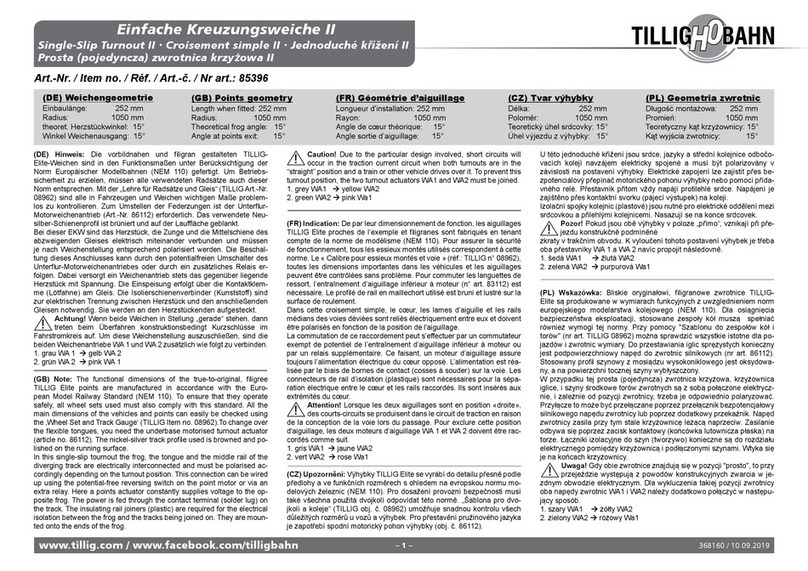
TILLIG Modellbahnen
TILLIG Modellbahnen Single-Slip Turnout II quick start guide

Hangar 9
Hangar 9 Hangar 9 Solo instruction manual
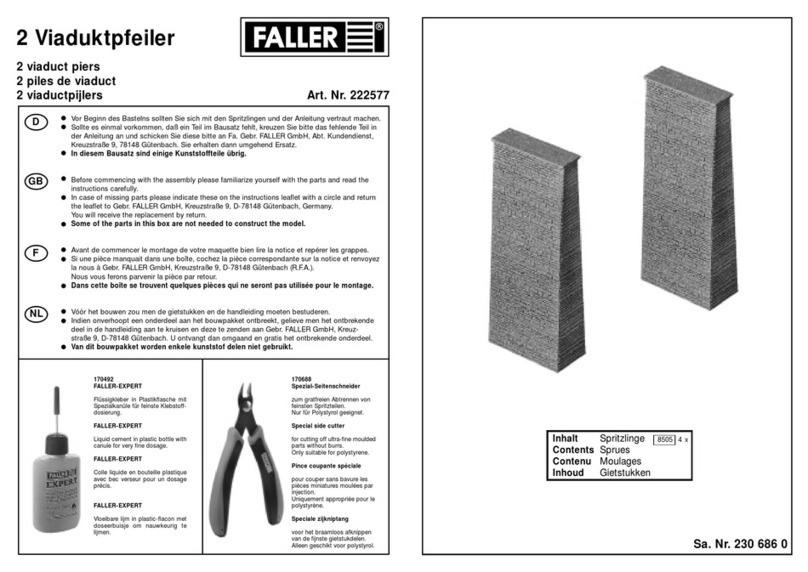
Faller
Faller 2 viaduct piers quick start guide
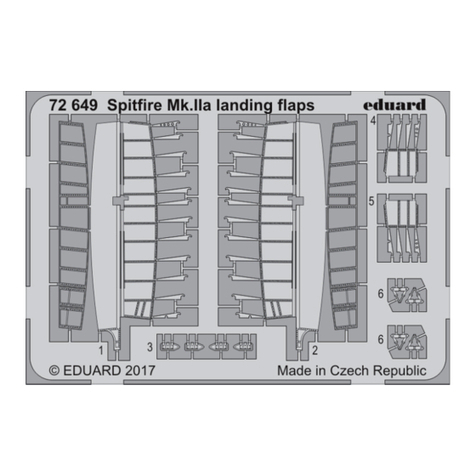
Eduard
Eduard Spitfire Mk.IIa landing flaps manual
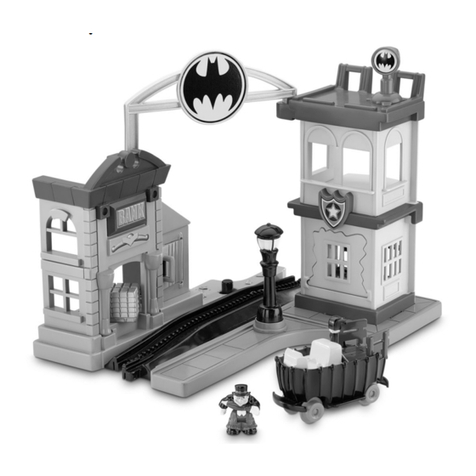
Fisher-Price
Fisher-Price GeoTrax V8490 instruction sheet
